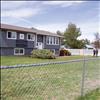Five tips for gardeners new to Montana
Hey savvy news reader! Thanks for choosing local.
You are now reading
1 of 3 free articles.
It’s been almost a decade since I spent my first glorious summer in the shadow of the Mission Mountains, which felt like heaven after living the entirety of my life in the humid eastern Texas heat that stifled from April to September. Over the years I’ve lived in numerous places across the western half of Montana, and wherever I’ve found myself I’ve always tried to grow things and have some sort of garden, even if it was on a tiny patio of my Kalispell apartment.
Over time I’ve had the privilege to live in places where my garden space has continued to grow, and as I’ve tried more and more plants, I’ve gotten better at it. It was frustrating to me at first. In Texas, it seemed as though anything you tossed in the soil would flourish. I had been taught by generations of gardeners and had grown up tending a one-acre plot with my family. When I arrived in Montana, I had little space and few resources, and nearly everything I had learned about seeds past “chunk ‘em in the dirt” seemed to be upended. The following are tips that new residents to the Mission Valley might find helpful when they try their hand at gardening, and I do encourage them to try, for whether it’s beauty or food production that is the end goal, gardening has always been worth the effort for me, even amongst some failures made by a southern girl in a northern land.
1. Assess your space and make a plan for it. I have wanted to grow butternut squash and giant pumpkins for years now, but it’s never been a real possibility until this year, where I will have more space. Space has always been a luxury. Even in my 20x20 plot in the Meadow Hill Community Garden in Missoula, there simply wasn’t enough space to accommodate the wide-ranging vines. This year I’ll get to try my first crop of butternuts, with squash seeds I bought when there was no possibility space-wise for me to grow them. The seeds have been waiting in my stash for years.
There are plenty of ways to grow vertically and container grow for folks with limited space. I’ve been in that situation for much of the past decade and every year I get better at assessing space-wise what I can and can’t grow, so I can pack as much into my growing season as possible. Do your research and make a plan.
2. Get your seeds from local sources. I was strolling the aisle of a box store last week and I came across five racks of bulbs and seeds that will likely never grow in Montana. These plants were suited for Zones 8-10, and as I looked into the empty bins, I wondered who had bought them all up? Maybe people with a greenhouse, but more likely beginner folks who saw a pretty photo and didn’t think to look at the growing zones, I thought. It’s a rookie mistake that I have done several times myself. There’s nothing wrong with getting seeds from a box store - just know your climate and pick the right ones.
I personally have found that shopping local seed stores are much more helpful than a trip to the box store. Some of the best seeds I have gotten over the years have come from Triple Divide Seeds in Ronan.
“Buying seeds locally does not only benefit the local markets, but it will benefit the growers as well,” Micah McClure of Westland Seed said. “Having seeds that have been historically used in an area will more likely be well-adapted to the certain growing conditions, allowing for a healthier growing plant.”
By going to a local store like Westland Seed you are also more likely to be able to get help from ag professionals who can help you steer clear of making a poor choice and can help guide you as you grow as a gardener over time.
Seed libraries are another great source of seeds that are often sourced locally. Missoula has one located in the public library.
3. Learn to save your own seeds. One year of bok choy gone wild means that I’ll likely never need to buy bok seeds again. By learning to save your own seeds you can help fuel next year’s harvest. Saved seeds can also be used to barter with other gardeners.
4. Make a plan for food preservation. Just five years ago I did not know how to dehydrate cherry tomatoes. I was ignorant of the ways of preserving home grown Chinese cabbage by blanching and freezing. I didn’t realize that my strawberries could freezer burn if I put them into the wrong container. If you plan to preserve something, do some research first. There are so many ways to preserve foods and the internet has much to offer. Try new things. Make your harvest last. While a store-bought tomato might taste like disappointment when compared to a home-grown one, a homegrown one laid to waste is an even greater devastation.
5. Become involved in community. There is no better resource than fellow gardeners in the area. Joining a community garden has been the one of the best experiences in my life. You turn compost together. You fight squash bugs together. You water each other’s plots when you are out of town and apologize when your sunflower spreads seeds across to your five neighbors. Growing things can be a gamble. It can be messy. But the people who do it share a kinship that’s worth exploring.















